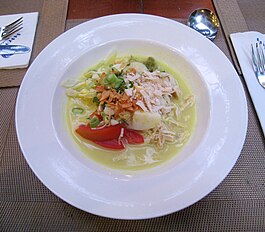Soto (food)

|
|
| Alternative names | Sroto, Coto, Tauto |
|---|---|
| Course | Main course |
| Place of origin | Indonesia |
| Region or state | Nationwide in Indonesia, Malaysia, Brunei and Singapore |
| Associated national cuisine | Indonesian cuisine |
| Serving temperature | Hot |
| Main ingredients | Various traditional Indonesian chicken, beef, or offal soups |
| Variations | Rich variations across Indonesia |
| |
|
Soto (also known as sroto, tauto, or coto) is a traditional Indonesian soup mainly composed of broth, meat and vegetables. Many traditional soups are called soto, whereas foreign and Western influenced soups are called sop.
Soto is sometimes considered Indonesia's national dish, as it is served from Sumatra to Papua, in a wide range of variations. Soto is omnipresent in Indonesia, available in many warungs and open-air eateries on many street corners, to fine dining restaurants and luxurious hotels. Soto, especially soto ayam (chicken soto), is an Indonesian equivalent of chicken soup. Because it is always served warm with a tender texture, it is considered an Indonesian comfort food.
Because of the proximity and significant numbers of Indonesian migrants working and settling in neighbouring countries, soto can also be found in Singapore and Malaysia, and has become a part of their cuisine.
Introduced to Suriname by Javanese migrants, it is part of the national cuisine of that country as well, where it is spelled saoto.
In the Indonesian archipelago, soto is known by different names. In the local Javanese dialect, it is called soto, while in Pekalongan it is called tauto, and the dish also reached Makassar where it is called coto. Soto is found to be most prevalent in Java, and suggested that the hearty soup was originated from that island, and over the years this dish branched off in an assorted array of soto varieties.
Although soto was undoubtedly developed in the Indonesian archipelago and each region has developed its own distinctive soto recipes, some historians suggest that it was probably influenced by foreign culinary tradition, especially Chinese. Denys Lombard in his book Le Carrefour Javanais suggested that the origin of soto was a Chinese soup, caudo, popular in Semarang among Chinese immigrants during colonial VOC era, circa 17th century.
...
Wikipedia
